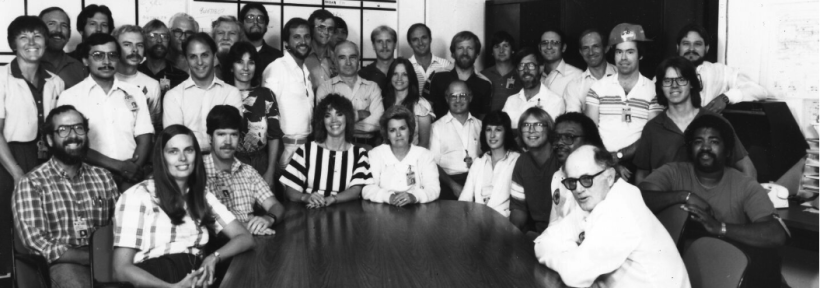Physical Science Careers Disrupted
Presiding over the 1962 dedication of AIP’s Niels Bohr Library & Archives, J. Robert Oppenheimer paused at the podium to reflect on a challenge

Robert Oppenheimer speaking at the Niels Bohr Library Dedication in New York
Oppenheimer believed that preserving records would reveal not only “a heroic time,” but also its “robbers and fools” alongside its “great and noble” people. His charge endures: In moments of upheaval, we must gather records so future generations can grasp what we ourselves struggle to see.
Today, as federal funding and policy shifts and reshapes the physical‐science enterprise, we take up that charge. Our research team is launching a new initiative to collect and preserve first-person accounts from scientists, engineers, and other professionals across the physical science enterprise whose careers and work are being disrupted.

We invite you to share your story through this online personal narrative form
Documenting a Once-in-a-Century Upheaval in the Physical Sciences
The rapid policy and funding shifts enacted by the second Trump Administration are upending the status quo of the physical science enterprise in the United States. Grants have been terminated
History offers few precedents. This spring, Will Thomas, AIP’s Director of Research in History, Policy, and Culture noted in his talk, What is Going on and is the Past any Guide?

Los Alamos National Laboratory scientists at a party
Today’s disruptions demand fresh documentation. To meet that need, we are establishing an ongoing process to collect firsthand accounts of careers derailed or redirected by these funding and policy changes—before details fade and institutional memory is lost. Each story will be added to the Niels Bohr Library & Archives’ digital repository
Personal Stories Give Voice to Organizational and Institutional Memory
As part of our focus on the federal physical-science workforce in our 2025 research agenda
These data alone do not convey the human toll of sudden layoffs, early retirements, or abandoned projects. We need the lived perspectives of scientists, engineers, technicians, policy staff, and others whose careers have been affected.

Lawrence Livermore National Laboratory X-Ray Laser Development Team
Stakeholders across our community have urged us to work to document not only personal hardships but also the institutional memory at risk when experienced professionals abruptly leave, when international collaborations are upended by visa policy issues, or when major grants are terminated or frozen. We developed this project in response. This effort advances our research team’s focus on

Frank Rhodes speaks at the National Science Foundation’s (NSF) 40th birthday
We designed this initiative to complement several excellent projects already underway. The American Physical Society is collecting personal accounts
How to share your story
If changes in federal funding or policy have cost you a job, pushed you toward early retirement, otherwise changed your employment situation, and/or if any other major federal policy changes or actions have affected your work, education, or career, we invite you to contribute your experience through our online personal narrative form
The form should only take about ten or twenty minutes to complete. It includes five core open-ended questions and one multiple-choice question about employment sectors. Your response will be of the most direct use to current and future researchers if you are comfortable sharing your name and specific information about your role. With that noted, we also appreciate that many participants may not want to share identifying information about themselves as part of this project. As a result, we provided options for participants to remain anonymous.
Here are the prompts for the five open-ended questions we are asking participants below for anyone who wants to draft up their responses before beginning to fill out the questionnaire.
- Tell us about yourself, your role (or former role), and your responsibilities.
- How did/does your work relate to the physical sciences?
- How are the changes in policies and funding affecting you personally and professionally?
- In your opinion, how might these changes in policies and funding affect the physical sciences or society more broadly?
- Is there anything else you would like to tell us about the impact of the changes in policies and funding for the physical sciences?
The form will remain open through at least August 2026 so we can document continuing developments. If your situation further changes during that period, or if you have other updates or reflections that you would like to share, you are welcome to fill in the form multiple times.
We also welcome digital photos submissions
What will happen with your story
Every relevant contribution will be added to AIP’s open-access digital repository, where it will sit alongside our biographical materials, memoirs, photographs, and oral history interviews. Stories will be added on a rolling basis, each as its own record—searchable, citable, and preserved for scholars today and tomorrow. For those who elect to have their stories embargoed, we will not provide access to those stories for a five-year period.

Dan Lester, Jesse Bregman, Harriet Dinerstein, Fred Witteborn, and Mr. Harold Crean on the Kuiper Airborne Observatory (KAO)
By default, submissions will be publicly viewable so the broader community can understand how funding and policy shifts are reshaping the physical-science enterprise. Please share only information you are comfortable making public at some point in time; if a narrative includes potentially sensitive details, we may restrict access to protect contributors’ privacy while still safeguarding the historical record.
Encourage others to share their stories
Help us widen the circle. If this initiative resonates with you, share it with colleagues, students, professional societies, friends, or mentors—and ask them to pass it on through their own networks and social-media channels.
If you are interested in collaborating more directly on outreach? Let’s talk. Feel free to email me (contact details on my bio page




